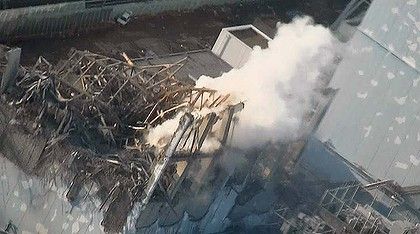For months, Tepco and Japanese officials refused to admit that there had been any meltdowns at Fukushima.
Then they said there were meltdowns at reactors 1, 2 and 3 ... but they might have only been partial meltdowns.
Finally, today, they admitted the obvious: there were total meltdowns at all 3 reactors. As CNN reports:
Japan's Fukushima Daiichi nuclear power plant experienced full meltdowns at three reactors in the wake of an earthquake and tsunami in March, the country's Nuclear Emergency Response Headquarters said Monday.As the Japan Times reports today, the Japanese Nuclear and Industrial Safety Agency has "more than doubled its estimate of the radioactive material ejected into the air in the early days of the Fukushima nuclear crisis".
The nuclear group's new evaluation, released Monday, goes further than previous statements in describing the extent of the damage caused by an earthquake and tsunami on March 11.
***
Reactors 1, 2 and 3 experienced a full meltdown, it said.
***
But Tokyo Electric [on May 24th] released a second possible scenario for reactors 2 and 3, one that estimated a full meltdown did not occur. In that scenario, the company estimated the fuel rods may have broken but may not have completely melted.
***
Temperature data showed the two reactors had cooled substantially in the more than two months since the incident, Tokyo Electric said in May.
***
Tokyo Electric avoided using the term "meltdown," and says it was keeping the remnants of the core cool. But U.S. experts interviewed by CNN after the company's announcement in May said that while it may have been containing the situation, the damage had already been done.
"On the basis of what they showed, if there's not fuel left in the core, I don't know what it is other than a complete meltdown," said Gary Was, a University of Michigan nuclear engineering professor and CNN consultant. And given the damage reported at the other units, "It's hard to imagine the scenarios can differ that much for those reactors."
Japan Times also notes that plutonium has been found in soil outside of the nuclear complex - about 1.7 kilometers from the front gate of Fukushima. However, the plutonium probably came from the so-called "hydrogen explosions", which hopefully won't happen again. (However, nuclear expert Arnie Gundersen believes that at least some of the explosions were caused by nuclear reactions in the fuel pools.)
While it is tempting to believe that the worst of the crisis is over, some of the reactors are more radioactive than ever, and nuclear chain reactions may still be occurring.
And it's not just the reactors themselves.
Remember that - when the spent fuel rods stored onsite within the reactor buildings are included - the amount of radioactive fuel at Fukushima dwarfs Chernobyl.
For background, see this.




with the explosions at #3 on the third day of the crisis, which blasted tons of MOX and Pu all over, this was already known to those that didnt buy the tepco BS